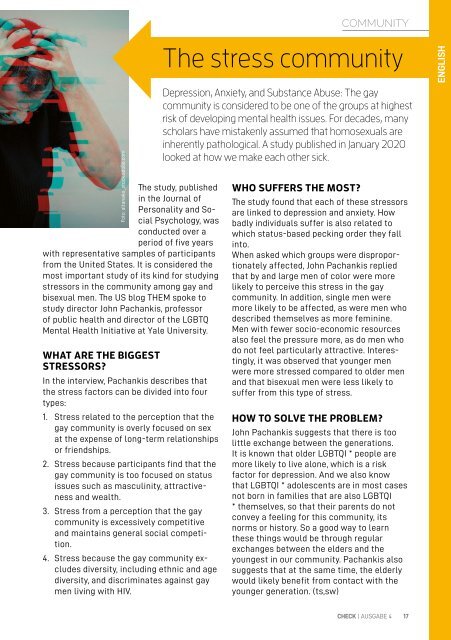CHECK Berlin #4
Sie wollen auch ein ePaper? Erhöhen Sie die Reichweite Ihrer Titel.
YUMPU macht aus Druck-PDFs automatisch weboptimierte ePaper, die Google liebt.
COMMUNITY<br />
Foto: altanaka_stock.adobe.com<br />
The study, published<br />
in the Journal of<br />
Personality and Social<br />
Psychology, was<br />
conducted over a<br />
period of five years<br />
with representative samples of participants<br />
from the United States. It is considered the<br />
most important study of its kind for studying<br />
stressors in the community among gay and<br />
bisexual men. The US blog THEM spoke to<br />
study director John Pachankis, professor<br />
of public health and director of the LGBTQ<br />
Mental Health Initiative at Yale University.<br />
WHAT ARE THE BIGGEST<br />
STRESSORS?<br />
In the interview, Pachankis describes that<br />
the stress factors can be divided into four<br />
types:<br />
1. Stress related to the perception that the<br />
gay community is overly focused on sex<br />
at the expense of long-term relationships<br />
or friendships.<br />
2. Stress because participants find that the<br />
gay community is too focused on status<br />
issues such as masculinity, attractiveness<br />
and wealth.<br />
3. Stress from a perception that the gay<br />
community is excessively competitive<br />
and maintains general social competition.<br />
4. Stress because the gay community excludes<br />
diversity, including ethnic and age<br />
diversity, and discriminates against gay<br />
men living with HIV.<br />
The stress community<br />
Depression, Anxiety, and Substance Abuse: The gay<br />
community is considered to be one of the groups at highest<br />
risk of developing mental health issues. For decades, many<br />
scholars have mistakenly assumed that homosexuals are<br />
inherently pathological. A study published in January 2020<br />
looked at how we make each other sick.<br />
WHO SUFFERS THE MOST?<br />
The study found that each of these stressors<br />
are linked to depression and anxiety. How<br />
badly individuals suffer is also related to<br />
which status-based pecking order they fall<br />
into.<br />
When asked which groups were disproportionately<br />
affected, John Pachankis replied<br />
that by and large men of color were more<br />
likely to perceive this stress in the gay<br />
community. In addition, single men were<br />
more likely to be affected, as were men who<br />
described themselves as more feminine.<br />
Men with fewer socio-economic resources<br />
also feel the pressure more, as do men who<br />
do not feel particularly attractive. Interestingly,<br />
it was observed that younger men<br />
were more stressed compared to older men<br />
and that bisexual men were less likely to<br />
suffer from this type of stress.<br />
HOW TO SOLVE THE PROBLEM?<br />
John Pachankis suggests that there is too<br />
little exchange between the generations.<br />
It is known that older LGBTQI * people are<br />
more likely to live alone, which is a risk<br />
factor for depression. And we also know<br />
that LGBTQI * adolescents are in most cases<br />
not born in families that are also LGBTQI<br />
* themselves, so that their parents do not<br />
convey a feeling for this community, its<br />
norms or history. So a good way to learn<br />
these things would be through regular<br />
exchanges between the elders and the<br />
youngest in our community. Pachankis also<br />
suggests that at the same time, the elderly<br />
would likely benefit from contact with the<br />
younger generation. (ts,sw)<br />
ENGLISH<br />
<strong>CHECK</strong> | AUSGABE 4<br />
17


















